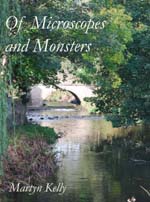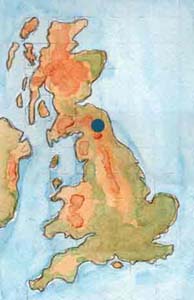
This series of pictures comes from the River Coquet high in the Pennines,
390 metres above sea level and just one and a half kilometres from the
Scottish border. The River Coquet here is only about a metre across. It
tumbles off the volcanic rocks that underlie this part of the Pennines – the
Cheviots – as a series of rocky riffles and slower-flowing pools, gradually
increasing in size as its slope decreases and it meanders through one of the
most beautiful and unspoilt valleys in northern England before joining the
North Sea at Amble. There is just one small market town, Rothbury, about 30
km downstream from where I stand and, otherwise, just small villages,
hamlets and farmland. So many walkers visiting this region have been
surprised to see what looks like raw sewage floating down the river at
certain times of the year.
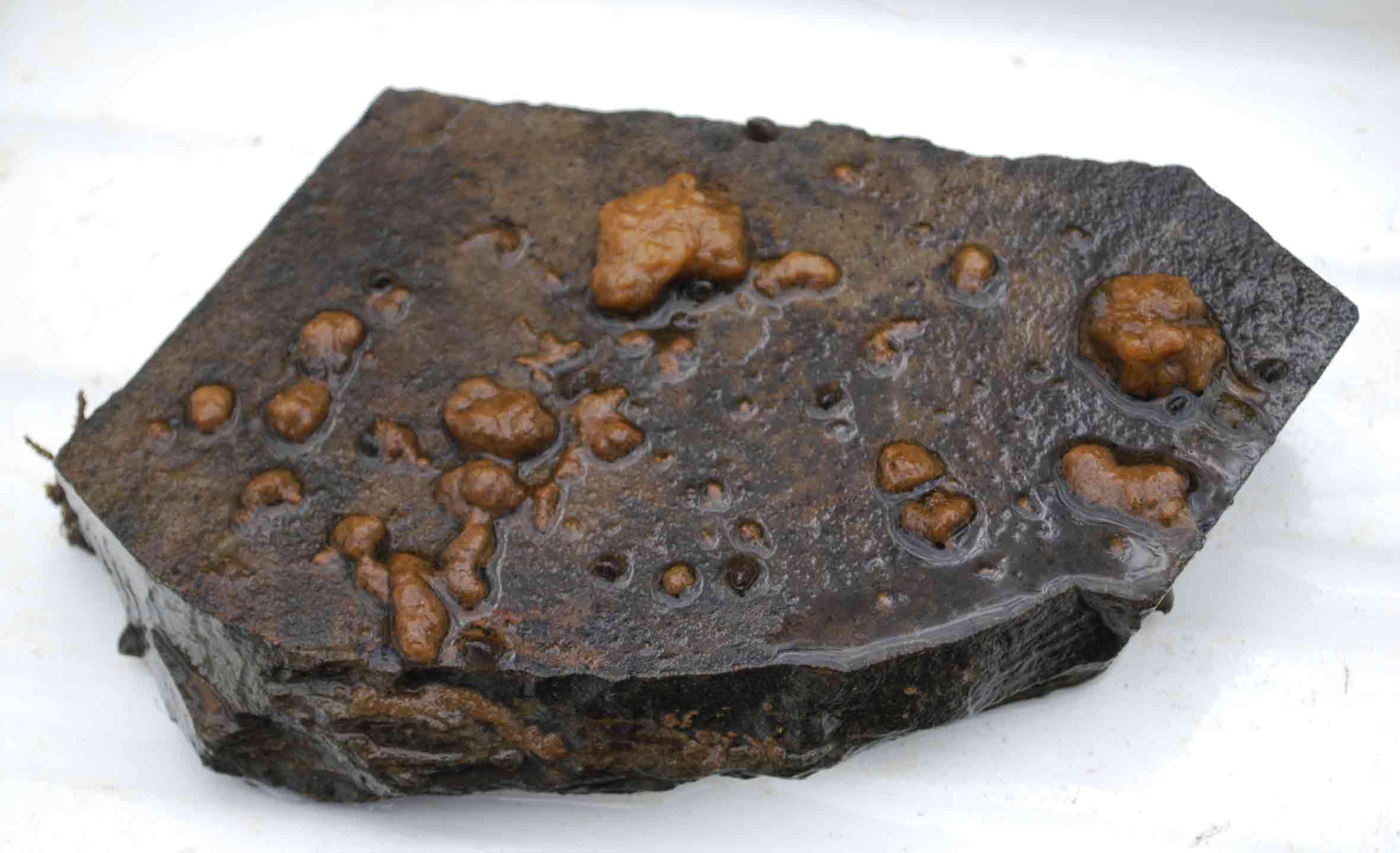
Crouching down beside a tiny tributary stream, only
half a metre or so across, I can see the culprit almost straight away
Lifting out one of the larger stones from the stream bed, I see tufts of
what look like soggy brown cotton wool. There are points further downstream
when these growths almost blanket the river bed in the summer, and you can
easily imagine that some of these, sheared from their substrate during a
spate, could be mistaken for raw sewage as they drifted down.
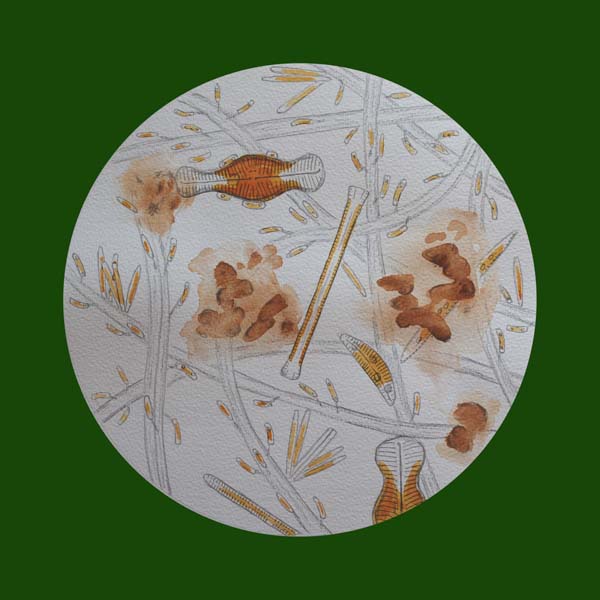
When I look down the microscope, what I can see is a series of almost
colourless, sometimes branched stalks criss-crossing the field of view. Just
occasionally, I can see a diatom which, at just over a tenth of a millmetre
long, is huge by the standards of most of the diatoms described on these
pages. The whole entity is 90 per cent or more stalk, pushing the cells
themselves – which belong to a species called
Didymosphenia geminata
– up towards the sunlight.
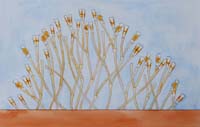
So the complete colony of
Didymosphenia - the tufts of soggy cotton wool mentioned above
- looks something like this, except that the stalks have many
smaller diatoms living on them as epiphytes. These tufts form dense
"copses" on the stone surfaces, with open areas in between, heavily
grazed by tiny Ancylidae snails.
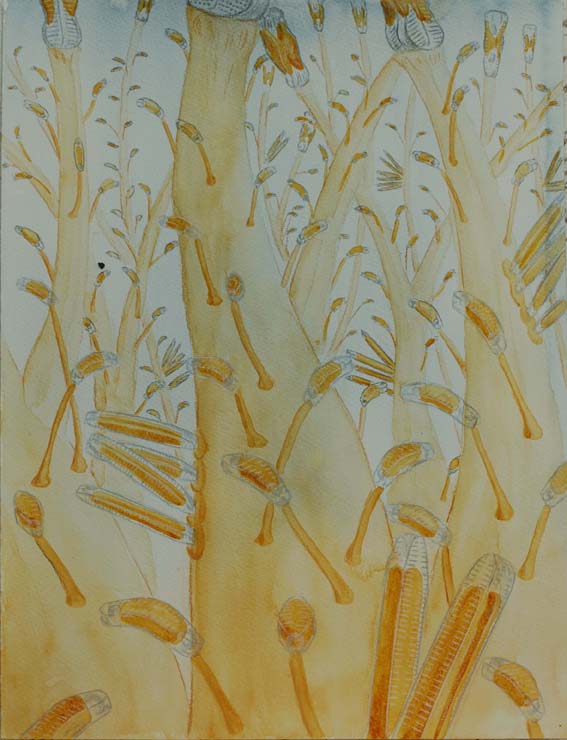
Finally, a view into a
Didymosphenia colony,
synthesising all these observations: the forest of branched stalks,
with each branch topped by a
Didymosphenia cell, and
smothered by short-stalked cells of
Achnanthidium minutissimum and other epiphytes.
 This series of pictures comes from the River Coquet high in the Pennines,
390 metres above sea level and just one and a half kilometres from the
Scottish border. The River Coquet here is only about a metre across. It
tumbles off the volcanic rocks that underlie this part of the Pennines – the
Cheviots – as a series of rocky riffles and slower-flowing pools, gradually
increasing in size as its slope decreases and it meanders through one of the
most beautiful and unspoilt valleys in northern England before joining the
North Sea at Amble. There is just one small market town, Rothbury, about 30
km downstream from where I stand and, otherwise, just small villages,
hamlets and farmland. So many walkers visiting this region have been
surprised to see what looks like raw sewage floating down the river at
certain times of the year.
This series of pictures comes from the River Coquet high in the Pennines,
390 metres above sea level and just one and a half kilometres from the
Scottish border. The River Coquet here is only about a metre across. It
tumbles off the volcanic rocks that underlie this part of the Pennines – the
Cheviots – as a series of rocky riffles and slower-flowing pools, gradually
increasing in size as its slope decreases and it meanders through one of the
most beautiful and unspoilt valleys in northern England before joining the
North Sea at Amble. There is just one small market town, Rothbury, about 30
km downstream from where I stand and, otherwise, just small villages,
hamlets and farmland. So many walkers visiting this region have been
surprised to see what looks like raw sewage floating down the river at
certain times of the year. Crouching down beside a tiny tributary stream, only
half a metre or so across, I can see the culprit almost straight away
Lifting out one of the larger stones from the stream bed, I see tufts of
what look like soggy brown cotton wool. There are points further downstream
when these growths almost blanket the river bed in the summer, and you can
easily imagine that some of these, sheared from their substrate during a
spate, could be mistaken for raw sewage as they drifted down.
Crouching down beside a tiny tributary stream, only
half a metre or so across, I can see the culprit almost straight away
Lifting out one of the larger stones from the stream bed, I see tufts of
what look like soggy brown cotton wool. There are points further downstream
when these growths almost blanket the river bed in the summer, and you can
easily imagine that some of these, sheared from their substrate during a
spate, could be mistaken for raw sewage as they drifted down. When I look down the microscope, what I can see is a series of almost
colourless, sometimes branched stalks criss-crossing the field of view. Just
occasionally, I can see a diatom which, at just over a tenth of a millmetre
long, is huge by the standards of most of the diatoms described on these
pages. The whole entity is 90 per cent or more stalk, pushing the cells
themselves – which belong to a species called Didymosphenia geminata
– up towards the sunlight.
When I look down the microscope, what I can see is a series of almost
colourless, sometimes branched stalks criss-crossing the field of view. Just
occasionally, I can see a diatom which, at just over a tenth of a millmetre
long, is huge by the standards of most of the diatoms described on these
pages. The whole entity is 90 per cent or more stalk, pushing the cells
themselves – which belong to a species called Didymosphenia geminata
– up towards the sunlight. So the complete colony of Didymosphenia - the tufts of soggy cotton wool mentioned above
- looks something like this, except that the stalks have many
smaller diatoms living on them as epiphytes. These tufts form dense
"copses" on the stone surfaces, with open areas in between, heavily
grazed by tiny Ancylidae snails.
So the complete colony of Didymosphenia - the tufts of soggy cotton wool mentioned above
- looks something like this, except that the stalks have many
smaller diatoms living on them as epiphytes. These tufts form dense
"copses" on the stone surfaces, with open areas in between, heavily
grazed by tiny Ancylidae snails. Finally, a view into a Didymosphenia colony,
synthesising all these observations: the forest of branched stalks,
with each branch topped by a Didymosphenia cell, and
smothered by short-stalked cells of Achnanthidium minutissimum and other epiphytes.
Finally, a view into a Didymosphenia colony,
synthesising all these observations: the forest of branched stalks,
with each branch topped by a Didymosphenia cell, and
smothered by short-stalked cells of Achnanthidium minutissimum and other epiphytes.



